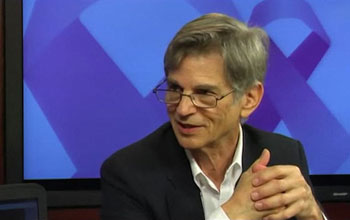News Release 11-248
Early Breast Cancer Detection Saves Lives
MammaCare technology sets standards for clinical breast exams
November 16, 2011
View a webcast with Mark Kane Goldstein, Ph.D, a founder and chairman of The MammaCare Corporation.
This material is available primarily for archival purposes. Telephone numbers or other contact information may be out of date; please see current contact information at media contacts.
MammaCare, a revolutionary tool that has set standards for teaching women and clinicians how to perform clinical breast exams, is training professionals around the country to detect lumps earlier and save lives.
Widely-publicized statistics inform women about the importance of early detection of cancer. The Center for Disease Control reports that second only to skin cancer, breast cancer is the most common cancer among American females.
The National Science Foundation funded an extensive series of tests designed to enhance the MammaCare technology and to advance the detection process for more effective and thorough training. MammaCare merges the results of these tests into tactually accurate breast models embedded with small, detectable, simulated lesions or lumps.
"MammaCare has created the recognized medical and scientific standard for performing and teaching breast examinations," said Mark Goldstein, a founder and chairman of the MammaCare Corporation. "You can't palpate a pamphlet but you can train fingers to reliably detect small lesions. We took a private event and made it a standard."
The MammaCare system aims to modernize education practices and materials related to cancer detection.
"We viewed the company as having valuable technology that replaced antiquated practices and that the NSF award could give a boost and modernize a product for education related to cancer detection, said Glenn Larsen, program director in the Engineering Directorate at NSF. "The panel and I saw this product as being of value throughout the world and of value in areas that might not have strong medical facilities or knowledge. It looked doubtful that the company could pull this off on their own resources and that NSF funding could contribute substantially to something with very broad impact not only here in the US but around the world."
-NSF-
Media Contacts
Deborah Wing, NSF, (703) 292-5344, email: dwing@nsf.gov
The U.S. National Science Foundation propels the nation forward by advancing fundamental research in all fields of science and engineering. NSF supports research and people by providing facilities, instruments and funding to support their ingenuity and sustain the U.S. as a global leader in research and innovation. With a fiscal year 2023 budget of $9.5 billion, NSF funds reach all 50 states through grants to nearly 2,000 colleges, universities and institutions. Each year, NSF receives more than 40,000 competitive proposals and makes about 11,000 new awards. Those awards include support for cooperative research with industry, Arctic and Antarctic research and operations, and U.S. participation in international scientific efforts.
Connect with us online
NSF website: nsf.gov
NSF News: nsf.gov/news
For News Media: nsf.gov/news/newsroom
Statistics: nsf.gov/statistics/
Awards database: nsf.gov/awardsearch/
Follow us on social
Twitter: twitter.com/NSF
Facebook: facebook.com/US.NSF
Instagram: instagram.com/nsfgov



